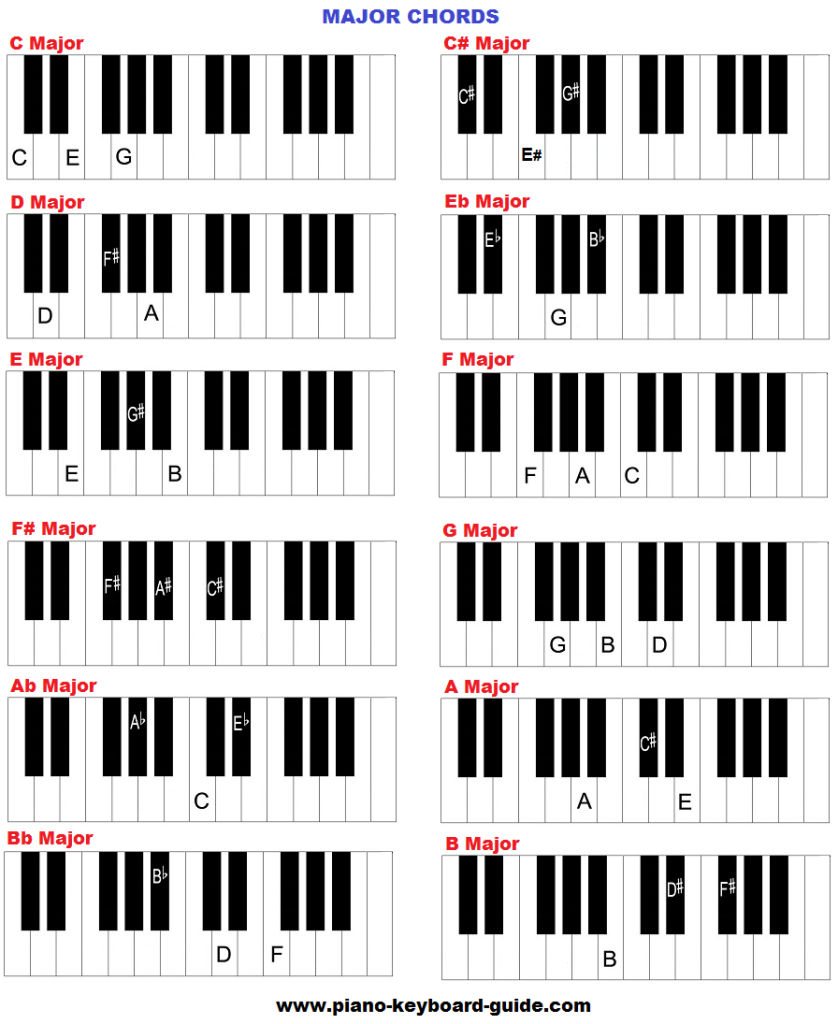In this lesson, you will learn how to play every major chord on piano. We will start with C major. To play a major chord, all you do is play a key, skip three keys, play a key, skip two keys and play a key. For instance, to form a C major chord, play C, skip three keys (C#, D and D#), play E, skip two keys (F and F#) and play G. It’s that simple.
Play C major with your right hand. Finger 1 (thumb) plays C, finger 3 (middle finger) plays E and finger 5 (little finger) plays G. Play it with your left hand as well. Finger 5 or your little finger plays C, finger 3 plays E and finger 1 plays G.
Watch this lesson:
Let’s move on to C sharp major. It consists of the notes C#, E# and G#. You can play this chord with fingers 1, 2 and 4 or fingers 1, 2 and 5. You can even play it with fingers 1, 3 and 5. It depends on how long your fingers are and how comfortable it feels. For D flat major, the same keys are played on your piano.
Let’s try D major. Its notes are D, F# and A. All you do is play a key, skip three keys, play a key, skip two keys and play a key. That’s all. There’s nothing hard about it.
Then you can move on to the E flat major chord whose notes are Eb, G and Bb. The same keys are played for the D sharp major chord, except that the notes have different names.
Try an E major chord. Play a key (E), skip three keys, play a key, skip two keys and play a key. This results in the notes, E, G# and B. Follow this chord with F major which consists of the notes, F, A and C.
See also: main Piano Chords page
Then play F# major with the notes, F# A# and C#. It’s an F sharp major chord because its notes are a half step (or semitone) higher than the notes of F major. It’s also G flat major because its notes are a semitone lower than the notes of G major.
Then we have G major. The notes of this chord are G-B-D. The notes of G# major are G#-B#-D#. On piano, the same keys are played for both G# major and the Ab major chord. The notes of Ab major are Ab-C-Eb. The notes of A major are A-C#-E. If you move one half step higher, you arrive at Bb major which consists of the notes, Bb, D and F. Bb uses the same piano keys as A# major.
Most of these chords can be played with fingers 1, 3 and 5. For instance, chords like C major, F major and G major can be played with fingers 1, 3 and 5. Some of the chords, such as C# major, can be played with fingers 1, 2 and 5. or even 1, 2 and 4.
Finally, we have B major which consists of the notes, B, D# and F#.
Practice all of these chords. This is what your chords should look like.
 Major Chords List:
Major Chords List:
C major: C–E–G
C sharp major: C#–E#–G# (D flat major: Db–F–Ab)
D major: D–F#–A
E flat major: Eb–G–Bb (D sharp major: D#-F##-A#)
E major: E–G#–B
F major: F–A–C
F sharp major: F#–A#–C# (G flat major: Gb–Bb–Db)
G major: G–B–D
A flat major: Ab–C–Eb (G sharp major: G#-B#-D#)
A major: A–C#–E
B flat major: Bb–D–F (A sharp major: A#-C##-E#)
B major: B–D#–F#
If you work at it, moving up and down the keys, one chord at a time, you will master it. You can start slowly, then pick up the pace as you improve. Practice both hands.
A good way to play the chords is note by note. Break up each chord into individual notes. For instance, let’s say you’re playing C major. Play C, followed by E, followed by G, then play C, E and G together. Move up the keyboard and do this for every chord. You can also go down your keyboard, and play chord after chord.
To learn more, get my piano chords book on Amazon or take my piano chords course on Udemy. All the best.